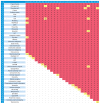Healthcare Information Technology: A Systematic Mapping Study
- PMID: 36792096
- PMCID: PMC9932305
- DOI: 10.4258/hir.2023.29.1.4
Healthcare Information Technology: A Systematic Mapping Study
Abstract
Objectives: This paper presents a systematic mapping of studies related to information systems and technology in the field of healthcare, enabling a visual mapping of the different lines of knowledge that can provide an overview of the scientific literature in this field. This map can help to clarify critical aspects of healthcare informatics, such as the main types of information systems, the ways in which they integrate with each other, and the technological trends in this field.
Methods: Systematic mapping refers to a process of classifying information in a given area of knowledge. It provides an overview of the state of the art in a particular discipline or area of knowledge, establishing a map that describes how knowledge is structured in that particular area. In this study, we proposed and carried out a specific implementation of the methodology for mapping. In total, 1,619 studies that combine knowledge related to information systems, computer science, and healthcare were selected and compiled from prestigious publications.
Results: The results established a distribution of the available literature and identified papers related to certain research questions, thereby providing a map of knowledge that structures the different trends and main areas of research, making it possible to address the research questions and serving as a guide to deepen specific aspects of the field of study.
Conclusions: We project and propose future research for the trends that stand out because of their interest and the possibility of exploring these topics in greater depth.
Keywords: Biomedical Technology; Health Information Technologies; Hospital Information System; Information System; Medical Informatics.
Conflict of interest statement
No potential conflict of interest relevant to this article was reported.
Figures









References
-
- Pendyala VS, Figueira S. Automated medical diagnosis from clinical data. Proceedings of 2017 IEEE 3rd International Conference on Big Data Computing Service and Applications (BigDataService); 2017 Apr 6–9; Redwood City, CA. pp. 185–90. - DOI
-
- Sia SK, Tang M, Soh C, Boh WF. Enterprise resource planning (ERP) systems as a technology of power: empowerment or panoptic control? ACM SIGMIS Database. 2002;33(1):23–37. doi: 10.1145/504350.504356. - DOI
LinkOut - more resources
Full Text Sources

